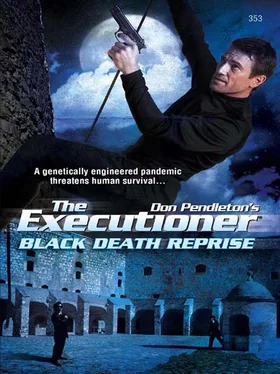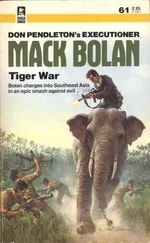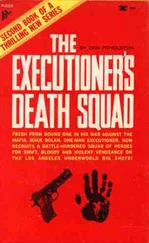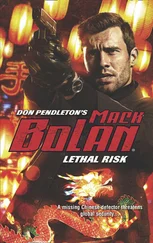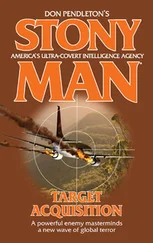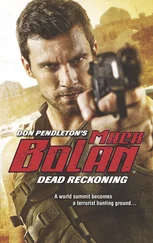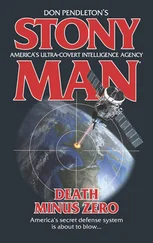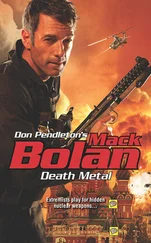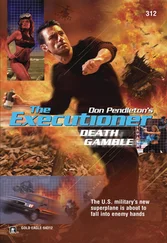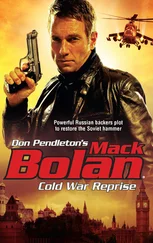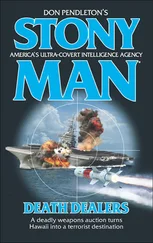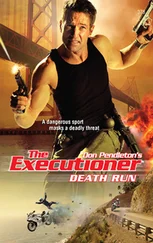Bolan shifted his aim to the three gunmen who were directing fire his way
Holding the submachine gun at waist level, he sprang from behind the cover of the tree and dashed forward, angling his way toward an outcropping of rocks. While he ran, he fired the Spectre in short bursts, engaging targets of opportunity as they appeared.
Bullets were flying through the air as Bolan launched himself into a dive that would take him to his intended spot behind the rocks. He felt the sudden sting of a round scratch the top of his scalp. He twisted in midair to direct his reply at the shooter, sending a burst of a dozen slugs into him and the man who knelt nearby.
“How’re you doing?” he asked into the mike as he grabbed one of his two remaining box magazines to replace the spent one.
“The M-60 is out,” LaFontaine shouted back.
“Throw the smoke and give me cover. I have plastique for the four corners. Let’s blow this building!” the Executioner shouted.
The Executioner ®

www.mirabooks.co.uk
Special thanks and acknowledgment to Peter Spring for his contribution to this work.
To lead an untrained people to war is to throw them away.
—Confucius, 551–479 BC
Evil men lead blind followers into battle unprepared for what they will face. What they will face is me—their Executioner.
—Mack Bolan
LEGEND
Nothing less than a war could have fashioned the destiny of the man called Mack Bolan. Bolan earned the Executioner title in the jungle hell of Vietnam.
But this soldier also wore another name—Sergeant Mercy. He was so tagged because of the compassion he showed to wounded comrades-in-arms and Vietnamese civilians.
Mack Bolan’s second tour of duty ended prematurely when he was given emergency leave to return home and bury his family, victims of the Mob. Then he declared a one-man war against the Mafia.
He confronted the Families head-on from coast to coast, and soon a hope of victory began to appear. But Bolan had broken society’s every rule. That same society started gunning for this elusive warrior—to no avail.
So Bolan was offered amnesty to work within the system against terrorism. This time, as an employee of Uncle Sam, Bolan became Colonel John Phoenix. With a command center at Stony Man Farm in Virginia, he and his new allies—Able Team and Phoenix Force—waged relentless war on a new adversary: the KGB.
But when his one true love, April Rose, died at the hands of the Soviet terror machine, Bolan severed all ties with Establishment authority.
Now, after a lengthy lone-wolf struggle and much soul-searching, the Executioner has agreed to enter an “arm’s-length” alliance with his government once more, reserving the right to pursue personal missions in his Everlasting War.
Chapter 1
Chapter 2
Chapter 3
Chapter 4
Chapter 5
Chapter 6
Chapter 7
Chapter 8
Chapter 9
Chapter 10
Chapter 11
Chapter 12
Chapter 13
Chapter 14
Chapter 15
Chapter 16
Chapter 17
Chapter 18
Chapter 19
A gentle breeze passing through the vineyard from the Pyrenees turned the leaves on their stems, making them appear to be waving to the man who glided silently through their tethered rows. The soothing rustle as they stirred on warm air currents, exposing undersides that shimmered a silvery-gray in the moonlight, was the only sound reaching Mack Bolan’s ears as he trod silently across the fertile fields that for more than eight hundred years had been producing wine for the St. Rafael Monastery north of Bayonne.
Dressed entirely in black, with green and brown camouflage paint smeared on the high points of his face to flatten his features, Bolan’s large frame was all but invisible against the inky French countryside.
On his hip, the ex-soldier wore a .44 Magnum Desert Eagle, while a holster on his left shoulder held a Beretta 93-R loaded with a 20-round clip of 9 mm Parabellum ammunition. A foot-long Fairbairn-Sykes combat knife, honed to a razor’s edge, rested in a weathered black leather sheath strapped to the outside of his right calf.
Bolan was approaching the monastery from the south because slipping into Spain at San Sebastian and traveling by car through the Pyrenees mountains to Bayonne was considerably easier for a heavily armed man than trying to fly into an airport, whether public or private, anywhere in France. The one hundred rounds of ammunition he brought for the Desert Eagle would have been impossible to get through French customs—never mind the concussion grenades and incendiary tape he carried in the pouches on his combat web belt.
As would most battle-tested veterans with whom death has become intimate enough to be a frequent visitor to their dreams, the man some called the Executioner was hoping not to use his weapons this night. But he had been schooled on the hellfire trail in distant jungles long enough to know firsthand that hope and death were frequent bedfellows. Those who came unprepared to kill at a moment’s notice, surrendering their fate to optimism or hope, were the ones who found themselves easy targets when a supposedly cold spot turned unexpectedly hot.
Despite the vineyard’s tranquil appearance, two CIA agents had been murdered there less than a week earlier, the homing device implanted in one’s deltoid muscle leading the Agency to a wooded area ten miles north, where the operatives’ bullet-ridden bodies had been discovered in a shallow grave. They had met their deaths while on the mission now assigned to Bolan—to rescue Dr. Zagorski from the confines of the ancient abbey.
Bolan’s Porsche 911 Turbo was hidden in a stand of trees about a mile south of the monastery where he had left it in order to approach his objective on foot, a tactic yielding the greatest variety of options. When combat veterans gained enough experience under fire, they learned that flexibility on the battlefield was what survival was all about—the soldier who ran out of options first was the one who died.
The choppy sound of helicopter blades cutting the air shattered the vineyard’s stillness with a noise that touched nerve endings buried deep within Bolan’s warrior psyche. He lowered himself to the ground, pressing his body against the single strand of heavy zinc wire. It ran about six inches above the soil the entire length of each row, alternately weaving inside and outside the slender trunks of adjacent vines, connecting an entire row into a supporting network able to withstand the rainstorms that rushed down the rugged slopes of the Pyrenees. The tended vines were leafless for the bottom two feet or so, forming a canopy under which Bolan would be concealed from the passing aircraft. Lying on his back, motionless to prevent an errant move from catching the eye of an alert passenger in the chopper, he waited for it to pass.
Coming straight across the vineyard, the helicopter was apparently not searching for intruders. As it whizzed past on a direct course for the monastery, more than ten rows to the right of where Bolan lay as still as a statue, he was able to see it was the Bell 206B-3 JetRanger that Hal Brognola told him the Order of Raphael had purchased six months earlier to replace their aging Hughes 300C. The new helicopter carried two-and-a-half times more weight, had room for four passengers and was almost twice as fast as the Hughes.
Bolan remained in place as he watched the chopper reach its destination. Abruptly illuminated by the landing pad’s powerful lights, it hovered like an apparition for a few moments before descending slowly out of sight. From satellite reconnaissance photos he had studied back at Stony Man Farm, Bolan knew the landing pad was a mere thirty yards from a guarded entrance to the research laboratory that was his objective.
Читать дальше
